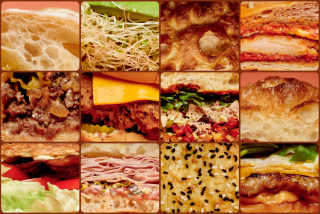Instant Classic
- Share via
Geoff Nathanson looked around at the happy parade of pirates, astronauts and hobos, and the anger welled inside him like the cardboard cheese rising between his cardboard bread slices. Of all the mothers in Los Angeles, why had his decided to dress her first-grader in a grilled-cheese sandwich costume?
Nathanson, now a resilient L.A. sports-radio guy in his late 30s, is about the only person I know with a legitimate reason to resent grilled cheese. To most of us it conjures pre-credit-debt memories of after-school specials and tall glasses of cold milk. Parents endorse the grilled cheese sandwich because of its concise ingredient list and ease of preparation. Kids love it because it’s cheese, and it’s grilled, and it’s a sandwich, which means you can eat it with your hands no matter how buttery.
Every cuisine seems to have its equivalent, whether the French croque-monsieur or the Mexican quesadilla or the Cuban cubano. In her book “Fashionable Food,” Sylvia Lovegren suggests that the grilled cheese sandwich as we know it was born as the “cheese dream” during Sunday-night suppers in the 1930s, when any substantial protein was considered a treat.
The standard red-white-and-blue model--American cheese between slices of Wonder Bread--has been permutated to fantastic heights.
Chef Thomas Keller, in his “French Laundry Cookbook,” uses thin slices of white farmhouse Cheddar between triangles of crustless brioche that have been brushed with clarified butter. Judy Rodgers’ “Zuni Cafe Cookbook” offers Fontina or Gruyere with sage and black pepper squeezed between slices of peasant-style bread. Deborah Madison, in “Vegetarian Cooking for Everyone,” tempts us with grilled cream cheese and fruit bread.
My wife and I decided a taste test was in order. The high-cholesterol contestants were an aged Cheddar from Quebec, a Swiss Gruyere, a Fontina and a sliced soy cheese (not because it merited inclusion, but because one of my daughters can’t eat cheese, and even the lactose-intolerant should get to play). For bread we alternated between a bakery loaf of light potato-rosemary and a store-bought package of sliced sourdough. I melted the butter and brushed it on for uniform golden-crispness.
The winner was Gruyere on potato-rosemary bread, though the cagey old Quebecois wasn’t far behind. The Fontina melted beautifully, almost lasciviously, but it couldn’t deliver the sharp flavor necessary to compete with the sweetness of the bread.
The Gruyere victory wasn’t surprising. Hard, dry cheeses take too long to melt (your bread might burn and your guests might grumble), and low-fat, skimmed-milk varieties tend to become stringy over heat. Gruyere is right in the middle, with plenty of nutty flavor, which helps to explain why it is the cheese of choice in a gratin savoyard, a classic Swiss fondue and French onion soup.
With European support for American policy hitting rough spots in recent months, we think the grilled Gruyere sandwich might prove to be a welcome point of consensus.
*
Grilled Gruyere Sandwiches
Serves 4
1 loaf potato-rosemary (or other soft white) bread, sliced to about 1/2-inch thickness
4 tablespoons melted butter
6 ounces Swiss Gruyere, thinly sliced
Place two slices of Gruyere between two slices of bread. Place under heavy cutting board and leave for 10 minutes. Brush one side of sandwich with butter and place butter-side-down on griddle or in frying pan, over low-to-medium heat. When bread is golden-brown, butter the top, flip sandwich and repeat, about 3 minutes on each side. Cut in half and serve hot.


